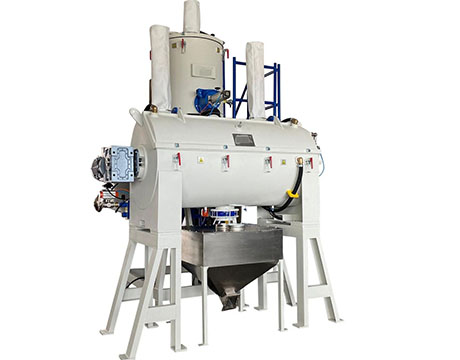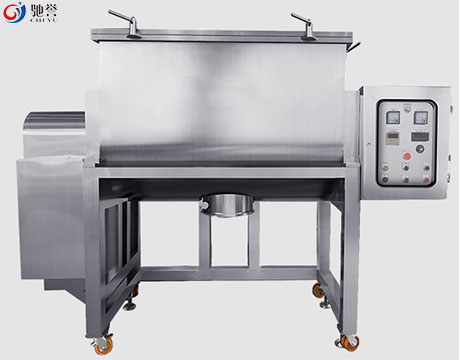Copyright © 2021 Zhangjiagang ChiYu Automation Equipment Co., Ltd. by iwonder.cn All rights reserved. Site Map
A PVC high speed mixer is more than just a machine—it's the entry point to efficient, stable production. To use it properly, you need more than technical specs. You need a step-by-step understanding of what happens from the moment the machine arrives to the minute your product exits the discharge port. This guide walks through each phase of that process with clear, actionable instructions.
PVC high speed mixers are designed to blend PVC resin with stabilizers, plasticizers, lubricants, pigments, and other additives. What sets them apart from traditional mixers is the speed of operation and the use of frictional heat.
When the blades spin at high RPMs, they generate internal heat, allowing additives to fuse more uniformly with the resin. The result is a free-flowing dry blend that meets the demands of extrusion, calendaring, or granulation processes. The entire cycle typically takes under 15 minutes.
What matters most, however, is not the technical principle—but how you run the machine to achieve consistent results.

Installing a PVC high speed mixer is not a one-step task. It involves preparing the environment, verifying infrastructure compatibility, and ensuring that every component is ready for continuous operation. Skipping any part of this preparation can lead to reduced efficiency or even mechanical failure.
The mixer should be installed on a level, reinforced concrete floor. This foundation must be able to support both the static weight and dynamic vibration of the machine during high-speed operation. Uneven placement or soft flooring introduces instability, which can damage the motor or shaft over time.
Use anchor bolts to secure the base of the machine. Tighten all mounting points firmly. If your setup includes anti-vibration pads, make sure they are correctly positioned and rated for the mixer’s load.
Connect the mixer to a three-phase power supply that matches the voltage and frequency requirements listed on the equipment label. Proper grounding is essential and should be verified with a qualified meter. Any inconsistencies in current can cause serious electrical faults.
If the mixer includes pneumatic systems—such as an automatic discharge valve or air-assisted sealing—check the compressed air source for pressure stability and dryness. Wet or unfiltered air leads to premature wear of seals and valve components.
Before adding materials or starting a production run, test the machine empty. Manually turn the blade shaft to confirm smooth rotation. Close the lid and engage the locking system. Ensure that safety switches respond correctly.
Power on the system and watch the control panel for error codes or sensor failures. All readings—temperature, rotation speed, and pressure (if applicable)—should stay within expected limits. Once confirmed, the mixer is ready for initial operation.
Daily operation should follow a consistent rhythm. No shortcuts. Even small missteps can lead to poor product quality or excessive equipment stress. Below is a standard procedure for processing one batch.
Start by checking your formulation. Load PVC resin first. Then add lubricants and stabilizers, followed by pigments and other fine powders.
Never exceed 80% of the mixer’s rated capacity. Overloading reduces blade efficiency, increases mixing time, and risks damaging the drive shaft. Use scales to verify total load weight.
Close the lid securely. Confirm that the lock sensors register closed status before starting.
On the control panel, set the blade speed—typically between 1000–1500 RPM depending on your recipe. Set mixing time based on your formulation standard. Most rigid PVC blends require 6–10 minutes.
If your system has multiple speed stages, program them in advance. For example, you might start at a lower RPM for powder dispersion and shift to a higher speed to complete homogenization.
As friction builds, so does heat. Your goal is to reach the ideal processing temperature without overshooting it. Most PVC high speed mixers are designed to top out around 120–130°C.
Watch the temperature display throughout the cycle. If it rises too quickly, reduce RPM or stop early. If it rises too slowly, check the blade sharpness or ingredient moisture level.
If your system features auto-cooling, verify that the cooling phase starts immediately after mixing ends.
Once the batch is complete, activate the discharge valve. The material should flow freely through the outlet. If clumping occurs, inspect the blade gap or residual moisture content.
Use a soft brush to clean the discharge area between batches. Never leave unmixed residue—it will affect the next run and could clog the valve actuator.
If you're processing similar formulations, dry cleaning is usually enough. Use compressed air and a long-handled brush to remove buildup.
For color changes or different formulas, wipe down the chamber walls with a dry lint-free cloth. Avoid chemical cleaners unless approved by the equipment supplier.

A PVC high speed mixer is powerful equipment with rapid internal motion and thermal buildup. Any lapse in attention can result in injury or equipment failure.
Always keep the lid closed during mixing. Safety switches should stop blade motion if the lid is opened, but never rely solely on automation.
Wear proper PPE. Gloves, goggles, and masks are non-negotiable, especially when handling dusty additives.
Never bypass safety interlocks. If the lid lock sensor fails, shut down the mixer and repair it—do not override it.
Inspect electrical enclosures weekly. Signs of overheating, moisture ingress, or wiring degradation are early indicators of deeper issues.
Train all operators on emergency shutdown procedures. Each machine should have an accessible, clearly labeled emergency stop button. Test it weekly.
Proper maintenance prevents long-term failures and keeps mixing quality consistent. Maintenance is not just about replacement—it’s about recognition and routine.
Before each shift:
Open the lid and check for material buildup on blades
Spin the shaft by hand to check for drag or imbalance
Verify temperature sensor readings with a manual thermometer
Confirm discharge valve motion and seal tightness
These tasks take under 10 minutes and prevent expensive surprises.
Once a week:
Remove blades and inspect for cracks, wear, or edge dullness
Clean the discharge port thoroughly
Check for loose motor mounts or base anchor bolts
Test the emergency stop button and lid interlock
Use a checklist and record the results. Maintenance logs help catch problems before they spread.
At the end of each month:
Check lubrication levels or grease points (if applicable)
Open the motor housing and inspect fan filters and wiring
Recalibrate temperature and time sensors
Inspect pneumatic lines and actuators for leaks or stiffness
Review energy usage—sudden increases may signal blade drag or bearing wear
If your team works in shifts, assign responsibility and rotate inspections to prevent oversight fatigue.

Machines eventually show signs of wear. What matters is how quickly and accurately you respond.
Vibration during operation usually comes from blade imbalance, loose mounting bolts, or overloading. Reduce the batch size and inspect shaft alignment.
Unusual noise can indicate a dry bearing or damaged seal. Shut down the machine and check all rotating parts. If the motor produces a high-pitched hum, inspect the capacitor or power supply.
Incomplete mixing often results from worn blades, an incorrect load sequence, or overused additives clumping together. Rethink your recipe before blaming the equipment.
Discharge blockage may mean material stuck near the valve, actuator failure, or buildup from past batches. Stop the mixer, open the valve manually, and inspect thoroughly.
Build a response log. For each error, record what happened, what you did, and what fixed it. Patterns often reveal root causes that aren’t obvious in a single event.
A PVC high speed mixer only performs well when it’s treated as a core part of your process—not a background machine. From proper installation on a stable foundation to correct loading sequences, speed settings, and regular maintenance, every step contributes to mixing consistency and equipment longevity. By building habits around safety, inspection, and troubleshooting, your production line stays efficient and responsive. For operations looking to invest in durable, high-performance mixing equipment, manufacturers like ChiYu offer reliable solutions engineered to meet the continuous demands of industrial PVC processing.
For inquiries, contact us at chiyumixer001@chiyumixer.com or visit www.chiyumixer.com.